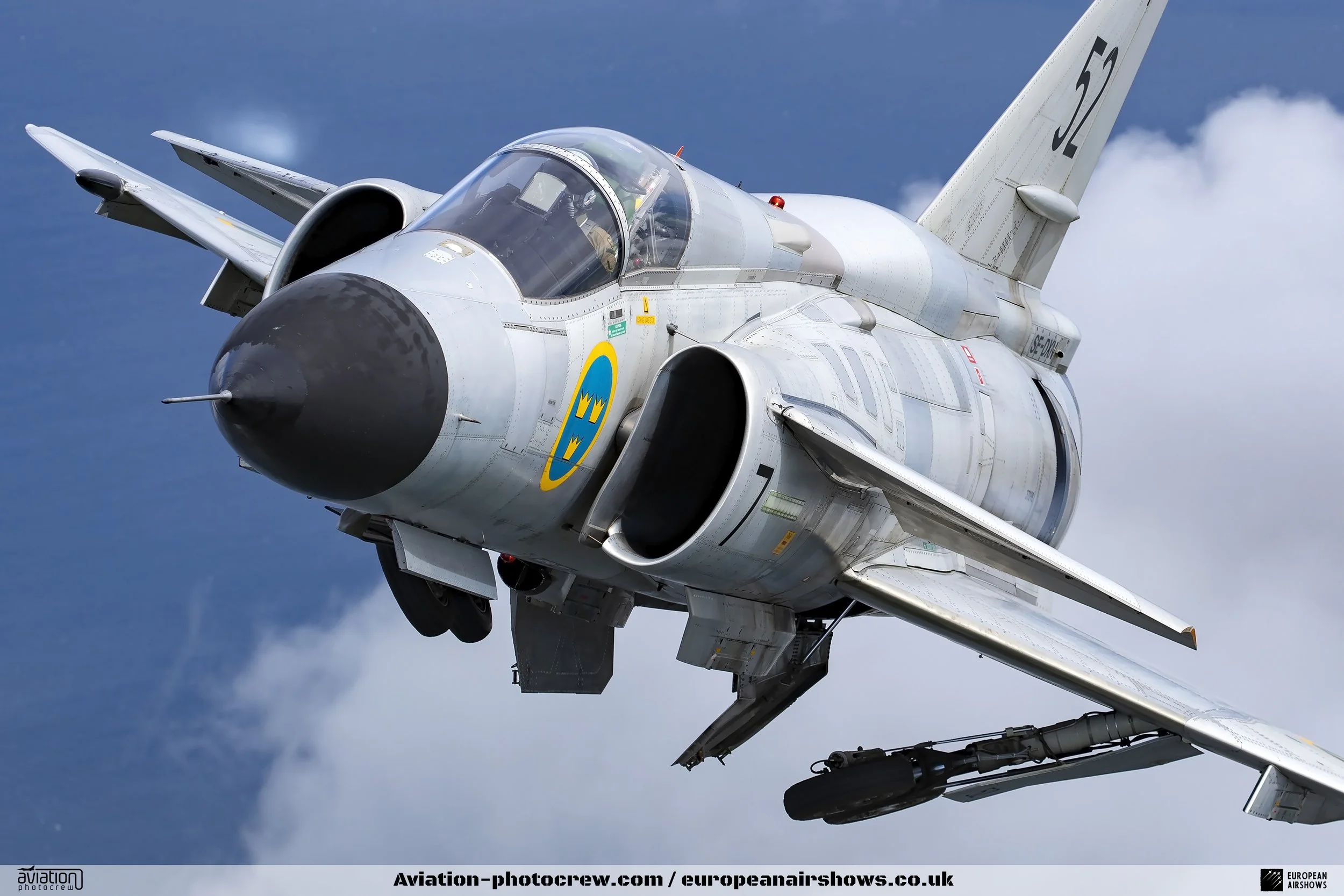
March 27 / Viggen SE-DXN First Post Restoration Flight
First flight 27 March 2012
Viggen SE-DXN
Picture this: a sleek, metallic beast tearing through the skies, its roar a testament to decades of engineering brilliance and human dedication. This isn’t just any aircraft; it’s a Saab 37 Viggen, a name that translates to “The Tufted Duck” or, more dramatically, “The Thunderbolt.” And Viggen SE-DXN? It’s a star with a story that stretches from the Cold War to the modern airshow circuit, blending technological innovation with a dash of nostalgia and a whole lot of grit.
The tale begins with the Saab 37 Viggen itself, a aircraft that redefined what a fighter jet could be. Born in Sweden—a nation famous for its neutrality and knack for punching above its weight in engineering—the Viggen was dreamed up in the early 1950s as a successor to the Saab 32 Lansen and Saab 35 Draken. Sweden’s military minds had big demands: they wanted a jet that could hit supersonic speeds at low altitudes, reach Mach 2 up high, and take off or land on runways as short as 500 meters—think highways or forest clearings, not fancy airbases. Why? Because Sweden’s defense strategy was all about dispersing its air force across the country in wartime, turning every road into a potential airstrip. Oh, and it had to play nice with the STRIL-60 national air defense system while being easy enough for conscripts to maintain. No pressure, right?
Saab’s engineers rose to the challenge with flair. After sifting through over 100 design concepts—including some bonkers vertical takeoff ideas they smartly ditched—they landed on a radical setup: a massive delta wing paired with a small, high-set canard foreplane. This wasn’t just a cool look; it gave the Viggen incredible maneuverability and the ability to leap into the air or touch down on a dime. Add to that the world’s first airborne digital central computer with integrated circuits—yep, a supercomputer in the cockpit—and you’ve got a jet that was light-years ahead of its peers. The prototype took its first flight on February 8, 1967, piloted by Erik Dahlström, who must’ve felt like he was riding a thunderbolt. By June 21, 1971, the first production Viggens were rolling into service with the Swedish Air Force, all 175 of them ordered in 1968. Europe had a new top dog in the skies, and it wouldn’t be outdone until the Panavia Tornado strutted onto the scene in 1981.
Now, let’s zero in on our hero, Viggen 37098. This particular bird hatched in 1977, a shiny new AJS 37 variant fresh from Saab’s factory in Linköping. The AJS 37 was a souped-up version of the original AJ 37 attack model, tweaked to be a multirole maestro capable of attack missions, reconnaissance, and even electronic warfare. Think of it as a flying Swiss Army knife, ready to tackle whatever the Cold War threw its way. Its home? The F 15 Wing at Söderhamn, a base nestled along Sweden’s eastern coast. For years, 37098 served faithfully, its Volvo RM8B afterburning turbofan engine—a beefed-up version of a Pratt & Whitney design—propelling it through countless missions. Painted in the Viggen’s iconic four-color camouflage, it blended into the Nordic landscape, a silent guardian of Swedish skies.
But all good things must end, and by the late 1990s, the Viggen’s time was up. The Swedish Air Force had a new darling, the JAS 39 Gripen, and the older jets faced a grim fate: scrapping or a quiet retirement as museum pieces. Viggen 37098 was no exception—until destiny intervened. In 2000, a band of aviation enthusiasts from the Swedish Air Force Historic Flight (SwAFHF) spotted its potential. These weren’t just hobbyists; they were on a mission to keep Sweden’s aviation legacy alive, one wrench turn at a time. They swooped in, rescuing 37098 from the scrapheap and hauling it to their base at the F 7 Wing in Såtenäs, southwest Sweden. What followed was a labor of love that would make any gearhead weep with pride.
Restoring a Viggen isn’t like fixing up an old jalopy. This was a complex beast with cutting-edge 1970s tech—hydraulics, avionics, flight controls, the works—all needing to be coaxed back to life. The volunteers pored over every inch, ensuring the RM8B engine could still roar and that the digital systems, once revolutionary, were up to snuff. But they weren’t just aiming to make it fly; they had to meet modern civil aviation standards, a tall order for a warbird designed for combat, not joyrides. They added a GPS and a modern radio for navigation and communication—small concessions to the 21st century—but kept the rest pure, preserving its original soul. And then there was the paint, or rather, the lack of it. Unlike its camouflaged siblings, 37098 was stripped to its bare metal skin, a gleaming tribute to the first Viggens delivered in the early 1970s before the camo craze kicked in. It was a bold choice, and boy, did it pay off.
After years of sweat and elbow grease, the big day arrived. On March 27, 2012, Viggen 37098—now christened SE-DXN under its civil registration—took to the skies again. That maiden flight from Såtenäs was a triumph, the roar of its engine echoing like a victory cry. The SwAFHF had done the impossible: they’d turned a retired warrior into a flying phoenix. And SE-DXN wasn’t content to stay grounded after that. It hit the airshow circuit with gusto, dazzling crowds in Sweden and beyond. Picture it: a silver streak slicing through the sky, its canard wings glinting in the sun, its pilots—many ex-military aces—showing off the agility that made the Viggen a legend. Aviation buffs snapped photos, jaws dropped, and the jet became a living tribute to Saab’s ingenuity and Sweden’s aviation prowess.
SE-DXN isn’t alone in its second act. The SwAFHF also nursed an SK 37 Viggen, a two-seat trainer (serial number 37809), back to flight as SE-DXO, which soared again on May 15, 2018. But 37098 remains the standout, its unpainted fuselage a rare sight among Viggens, most of which stayed cloaked in camouflage. It’s a time capsule, a throwback to the jet’s early days, and a crowd favorite wherever it goes. From its birth in 1977 to its military service at Söderhamn, from the brink of oblivion to its rebirth as a flying icon, Viggen 37098/SE-DXN is more than metal and machinery. It’s a testament to the volunteers who refused to let it die, a thunderbolt that keeps striking awe into hearts worldwide. So next time you hear that engine roar overhead, tip your hat to the duck that wouldn’t quit—it’s one hell of a bird.
SE-DXN Facts
It’s a Rare Multirole Masterpiece: Viggen 37098 is an AJS 37 variant, a scarce version of the Saab 37 Viggen crafted for the Swedish Air Force. Unlike standard fighters, this jet was a triple-threat: built for attack, reconnaissance, and electronic warfare. Only a handful of AJS 37s were ever made, and its ability to switch roles mid-mission made it a Swiss Army knife of the skies—a rarity in the 1970s aviation world.
It Escaped Retirement to Soar Again: Built in 1977, this Viggen served with the F 15 Wing at Söderhamn until the late 1990s, when it faced the fate of most retired jets: the scrapyard. But in 2000, the Swedish Air Force Historic Flight (SwAFHF) intervened, restoring it to full flight capability. Now registered as SE-DXN, it’s one of the few Viggens still airborne, defying the odds to thrill audiences decades later.
It Pioneered the Digital Cockpit: Long before smartphones, Viggen 37098 was flying with a digital brain. It was the first aircraft in the world to feature an airborne central computer with integrated circuits, introduced in the 1970s. This cutting-edge tech gave pilots unmatched precision in navigation and combat, making it a trailblazer that influenced every modern fighter jet that followed.
Its Engine Redefines Swedish Power: Ever heard a jet hit Mach 2.1? That’s the roar of Viggen 37098’s Volvo RM8B afterburning turbofan engine. Adapted from the American Pratt & Whitney JT8D, this Swedish-tuned powerhouse was customized to launch the Viggen from short, rough runways—like highways—proving that Scandinavian engineering could outmuscle its global rivals.
It Shines Without Camouflage: Most Viggens sported a four-color camouflage to vanish into Sweden’s landscapes, but 37098 breaks the mold. Restored with a bare metal finish, its unpainted silver skin gleams like a time capsule from the early 1970s, when the first Viggens rolled out unpainted. This unique look makes it a standout rarity among its peers.
Its Revival Was an Epic Feat: Restoring Viggen 37098 wasn’t just maintenance—it was a saga. The SwAFHF team hunted down obsolete parts, modernized 1970s avionics for today’s regulations, and reinforced an airframe worn by years of service and storage. This Herculean effort turned a grounded relic into a flying phoenix, showcasing unparalleled dedication.
It Steals the Show Across Europe: As SE-DXN, this Viggen isn’t parked in a hangar—it’s a headliner at airshows across Europe. Piloted by skilled ex-military aviators, it dazzles crowds with the same agility it once wielded in combat. Its roaring flybys are a live-action history lesson, proving that Cold War tech still has star power.
Its Serial Number Unlocks a Hidden Story: The number 37098 isn’t just a label—it’s a key to this jet’s past. This unique serial ties it to its production in 1977, its missions with the F 15 Wing, and its journey to restoration. Aviation sleuths can use it to map out every chapter of its life, making it a living archive of Swedish military history.
It Was Built for Highway Takeoffs: During the Cold War, Sweden needed a jet that could fight without fancy bases. Viggen 37098 was designed to take off and land on improvised runways—like public roads or forest clearings. This quirky capability reflects Sweden’s neutral-but-ready stance, turning a rural highway into a launchpad for a supersonic defender.
It’s a Flying Time Machine: Here’s the jaw-dropper: Viggen 37098 still flies today. While most of its siblings are museum pieces or scrap, the SwAFHF keeps this Cold War icon airborne. Each flight is a rare chance to see 1970s tech in motion, blending raw power with historical significance—a living legend that refuses to fade into the past.

















